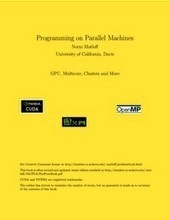
|
FreeComputerBooks.com
Links to Free Computer, Mathematics, Technical Books all over the World
|
|
- Title: Programming on Parallel Machines: GPU, Multicore, Clusters and More
- Author(s) Norm Matloff
- Publisher: University of California (July 17, 2012); eBook (Creative Commons Licensed)
- License(s): CC BY-ND 3.0 US
- Paperback: N/A
- eBook: PDF (410 page, 2.55 MB), ePUB, Kindle, Text, etc.
- Language: English
- ISBN-10: N/A
- ISBN-13: N/A
- Share This:

|
Parallel machines provide a wonderful opportunity for applications with large computational requirements. Effeective use of these machines, though, requires a keen understanding of how they work. In only a few years, many standard software products will be based on concepts of parallel programming implemented on such hardware, and the range of applications will be much broader than that of scientific computing, up to now the main application area for parallel computing.
The main goal of the book is to present parallel programming techniques that can be used in many situations for many application areas and which enable the reader to develop correct and efficient parallel programs. Many examples and exercises are provided to show how to apply the techniques
The main programming language used is C (C++ if you prefer), but some of the code is in R, the dominant language is the statistics/data mining worlds. The reasons for including R are given at the beginning of Chapter 10, and a quick introduction to the language is provided. Some material on parallel Python is introduced as well.
About the Authors- Norm Matloff is an American professor of computer science at the University of California, Davis. He was formerly a statistics professor at that university, and thus approaches the subject matter here as both a statistician and computer scientist.
- Parallel Computing and Programming
- Algorithms and Data Structures
- Computational Complexity
- Computational and Algorithmic Mathematics

- Programming on Parallel Machines: GPU, Multicore, Clusters and More (Norm Matloff)
- The Mirror Site (1) - PDF, ePub, Kindle (Mobi), etc.
- The Mirror Site (2) - PDF
- The Mirror Site (3) - PDF
-
 Parallel Programming with CUDA: Architecture, Analysis, Application
Parallel Programming with CUDA: Architecture, Analysis, Application
This book offers a detailed guide to CUDA with a grounding in parallel fundamentals. With CUDA, you can use a desktop PC for work that would have previously required a large cluster of PCs or access to a High-Performance Computing (HPC) facility.
-
 BIG CPU, BIG DATA: Solving the World's Toughest Problems
BIG CPU, BIG DATA: Solving the World's Toughest Problems
This book teaches you how to write parallel programs for multicore machines, compute clusters, GPU accelerators, and big data map-reduce jobs, in the Java language, with the free, easy-to-use, object-oriented Parallel Java 2 Library.
-
 Data Parallel C++: Mastering DPC++ Programming
Data Parallel C++: Mastering DPC++ Programming
Learn how to accelerate C++ programs using Data Parallelism. This book enables C++ programmers to be at the forefront of this exciting and important new development that is helping to push computing to new levels.
-
 Pro TBB: C++ Parallel Programming with Threading Building Blocks
Pro TBB: C++ Parallel Programming with Threading Building Blocks
This book is a modern guide for all C++ programmers to learn Threading Building Blocks (TBB). It presents numerous examples and best practices to help you become an effective TBB programmer and leverage the power of parallel systems.
-
 Introduction to Parallel Computing (Blaise Barney)
Introduction to Parallel Computing (Blaise Barney)
This book explains how to design, debug, and evaluate the performance of distributed and shared-memory programs. It teaches how to compile, run and modify example programs. It is a complete end-to-end source of information on almost all aspects.
-
 The Practice of Parallel Programming (Sergey A. Babkin)
The Practice of Parallel Programming (Sergey A. Babkin)
This book provides an advanced guide to the issues of the parallel and multithreaded programming. It goes beyond the high-level design of the applications, into the details that are often overlooked but vital to make the programs work.
-
 Is Parallel Programming Hard? If So, What Can You Do About It?
Is Parallel Programming Hard? If So, What Can You Do About It?
It examines what makes parallel programming hard, and describes design techniques that can help you avoid many parallel-programming pitfalls. It is primarily intended for low-level C/C++ code, but offers valuable lessons for other environments as well.





